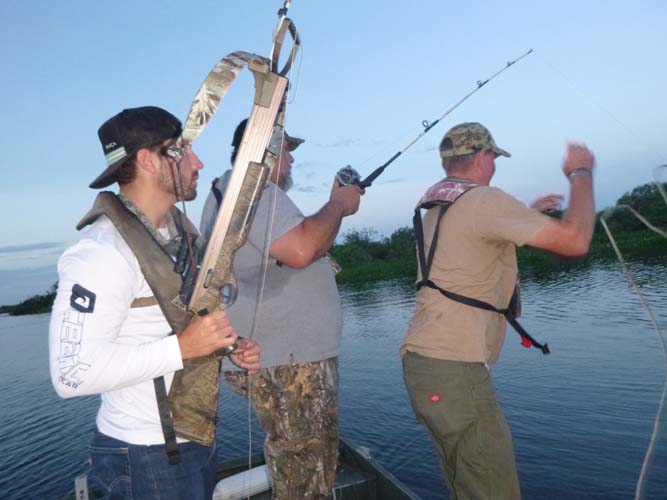Captain Scott Swartley and passengers Joe Avila and Cal Stewart watched anxiously from the deck of Swartley’s airboat as an 8-foot alligator swam toward a floating beef lung tied to their fishing line.
“Pop it, pop it again,” Swartley directed Avila, who picked up a fishing stout rod and jigged it a few times to make the bait bounce on the Stick Marsh’s placid surface.
“He’s on it!” Stewart whispered excitedly as the reptile gulped the bait.
Avila cranked the reel as Swartley started the engine and caught up with the fleeing gator, invisible on the murky bottom except for some surface bubbles. The captain cast out a heavy three-pronged snatch hook tied to a rope and snagged the gator, struggling to pull it to the surface.
As the gator emerged, thrashing and bashing the side of the airboat, Stewart shot it behind the head with a crossbow – not intending to kill it (which wouldn’t have worked anyway), but to secure it with a heavy line attached to the arrow for a quick dispatch on the surface.
As Swartley held the snapping animal next to the boat, Stewart jammed it point-blank in the head with a bang stick – a cartridge attached to the end of pole that fires when shoved against the gator’s hide – which stopped it temporarily.
“He’s not dead and he can still bite you,” Swartley said. “Tape his jaws.”
Stewart quickly wrapped a few layers of electrical tape around the rough, toothy maw, and then cut the animal’s spinal cord with a pocket knife. It stopped moving altogether, and the three men heaved it onto the deck.
“That’s a rush,” Stewart breathed of his first-ever gator hunt last week.
The three men were among thousands of Floridians and out-of-staters who participated in the Aug. 15 opening night of Florida’s annual statewide public gator hunt which runs through Nov. 1.
Each summer since 1988, after the animals were removed from the federal endangered species list, the state has conducted the recreational hunt, holding random drawings for limited-entry permits for numerous rivers, lakes and marshes.
The Florida Fish and Wildlife Conservation Commission calls Florida’s gator population today “stable” and estimates it at 1.3 million. This season, the agency issued more than 7,500 permits, allowing each hunter to take two gators of any size.
Legal hunting methods include: bow-and-arrow; crossbow; gig; harpoon; spear; snare; snatch hook; and fishing rod.
Unlike on some popular hunting television shows, pistols and rifles are not allowed. And hunters may not use a baited hook on a fishing line to catch an alligator. The bait Swartley used was secured to the line with a wooden peg – not a hook.
The annual hunt is so popular it usually sells out or comes close to it every year. And it’s not cheap.
Florida residents fork over $272 for a permit; out-of-state residents pay a whopping $1,022. While plenty of hunters are self-guided, many others choose to hire a professional guide such as Swartley – a veteran nuisance gator trapper and tour guide operator who lives in Malabar.
Swartley charges $750 for a night of hunting aboard his airboat, including all necessary equipment, and he’s pretty well booked throughout the season.
Avila – Swartley’s neighbor – is an experienced hunter, but not with gators. He said he wanted to go with Swartley to learn the ropes and to treat his friend Stewart before the Lexington, Kentucky resident enters U.S. Marine Corps officer candidate school in Virginia next month.
“I like to go with the best, whether it’s charter fishing, hunting, whatever,” Avila said. “You waste a whole lot less time and money if you learn to do it right.”
Avila was one of 43 lucky sportsmen drawn for the Stick Marsh – a bountiful 6,500-acre impoundment in northwestern Indian River County revered for big bass and huge alligators. The flooded former farm field holds the distinction of harboring the largest average length in the state for gators harvested in 2017 – 10 feet, 1.6 inches. Last season, 26 animals were taken that measured 11 feet or longer.
Though only a little over 8 feet, the party’s first gator of the night more than made up for its relatively small size with feistiness. Their second target – about the same size – was bested much more quickly.
Swartley’s headlamp picked up its ruby-red eyes in the dark; he ran up on it with the airboat and Stewart nailed it through-and-through with the crossbow using a laser sight. The gator was quickly dispatched with the bang stick and pocket knife.
The hunters said they planned to feast on gator meat and maybe have mounts made of the heads.

